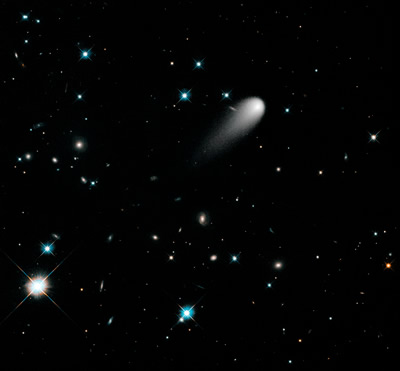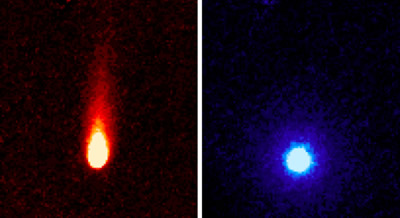

Hubble image of Comet ISON - Credit: NASA, ESA, and the Hubble Heritage Team (STScI/AURA)
Comet PANSTARRS has made its appearance, but what of the next great comet? It's time to take a look at Comet ISON again. In this photo taken with the Hubble Space Telescope's Wide Field Camera on April 30, 2013, we see ISON picturesquely posed against a field of foreground stars and distant galaxies. The icy traveler with the lengthening tail appears almost to be caught in a wonderland of celestial objects.
As we look at this image, we know the comet is much closer than the other objects. The Hubble team points out the nearest star to the Sun is over 60,000 times farther away, and the closest large galaxy is about 30 billion times more distant than it appears. Thanks to "Hubble Vision" we're able to see all the wonders of the universe in one image - from close comets to far-flung galaxies.
However, Hubble isn't the only telescope that's been busy checking out Comet ISON. Astronomers using NASA's Spitzer Space Telescope have seen what could be carbon dioxide emissions.

These images from NASA's Spitzer Space Telescope of C/2012 S1 (Comet ISON) were taken on June 13, when ISON was 310 million miles (about 500 million kilometers) from the sun. Image credit: NASA/JPL-Caltech/JHUAPL/UCF
On June 13, 2013, the Spitzer imaged Comet ISON with its Infrared Array Camera and observed carbon dioxide - along with dust - evenly spewing away from the comet's nucleus. This, in turn, is creating a spectacular tail which could be as much as 186,400 miles long. That's more than half the distance between the Earth and Moon!
"We estimate ISON is emitting about 2.2 million pounds (1 million kilograms) of what is most likely carbon dioxide gas and about 120 million pounds (54.4 million kilograms) of dust every day," said Carey Lisse, leader of NASA's Comet ISON Observation Campaign and a senior research scientist at the Johns Hopkins University Applied Physics Laboratory in Laurel, Maryland. "Previous observations made by NASA's Hubble Space Telescope and the Swift Gamma-Ray Burst Mission and Deep Impact spacecraft gave us only upper limits for any gas emission from ISON. Thanks to Spitzer, we now know for sure the comet's distant activity has been powered by gas."
At the time of this observation, Comet ISON was positioned about 312 million miles from the Sun - or about 3.35 times farther than Earth.
"These fabulous observations of ISON are unique and set the stage for more observations and discoveries to follow as part of a comprehensive NASA campaign to observe the comet," said James L. Green, NASA's director of planetary science in Washington. "ISON is very exciting. We believe that data collected from this comet can help explain how and when the solar system first formed."
So what of Comet ISON? Right now, scientists theorize the comet is about the size of a small mountain and could be around 3 miles in diameter and weigh between 7 billion and 7 trillion pounds. It is widely accepted at this point that C/2012 S1 is making its first pass through our solar system and will pass within 724,000 miles of the Sun on November 28, 2013.
As it nears perihelion, its mix of gases are heating up and disclosing themselves to monitoring equipment located both here on Earth and in space. According to researchers, carbon dioxide could well be the gas that powers emission for most comets located between the orbits of Saturn and the asteroids. When it was discovered by Vitali Nevski and Artyom Novichonok at the International Scientific Optical Network (ISON) near Kislovodsk, Russia, comet ISON was located roughly between the orbits of Saturn and Jupiter - and its abundance of carbon dioxide may have made this early detection possible.
"This observation gives us a good picture of part of the composition of ISON, and, by extension, of the proto-planetary disk from which the planets were formed," said Lisse. "Much of the carbon in the comet appears to be locked up in carbon dioxide ice. We will know even more in late July and August, when the comet begins to warm up near the water-ice line outside of the orbit of Mars, and we can detect the most abundant frozen gas, which is water, as it boils away from the comet."
Original Story Souce: HubbleSite News Release and JPL/NASA Spitzer News Release

















